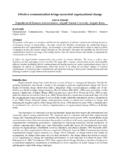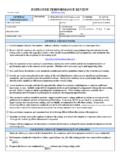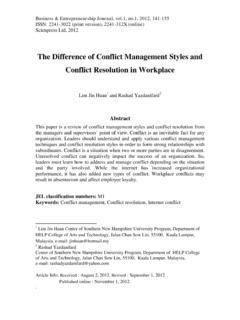Transcription of Goal Setting and Achieving - Employee Engagement
1 Creating and Implementing effective goals Goal Setting and Achieving Creating and Implementing effective goals goals A goal is an intended outcome or objective which can be established for long-term or short-term results. Although this worksheet is focused on your job at [COMPANY], goals can be written and applied to all aspects of your life. The most successful goals are: Linked to company goals Written Reviewed often Shared goals provide direction and identify specific areas of focus. Developed using the SMART model, they will help establish time frames and specific actions that will help employees be successful. Types of goals There are three types of goals that will be considered for this exercise: Productivity goals address your day-to-day job functions; these can be both long- and short-term plans and are often developed during the annual assessment process Developmental goals are focused on your growth within the company; often developmental goals include long-term plans Career goals are the long-term goals that you have within the company for your career beyond one year.
2 These goals are meant to prompt you to create a clear direction for yourself and provide your supervisor with your thoughts on the future. Description of a SMART goal: A SMART goal is developed by including these components. SMART goals are: Specific Measureable Action-oriented Realistic Time bound Specific Know what you are targeting for your SMART goals and be as specific as you can. To help determine your direction, consider: Company, business line, region, department goals [COMPANY] competencies Past performance assessments Supervisor and peer input Some target areas might be: Sales Quality Communication Productivity Efficiency Service Utilization Visibility Proposals Bookings Leadership Writing Measureable SMART goals are measureable in some way.
3 It is important to be able to be able to measure: Progress Completion Without those measurements, it is difficult to truly identify whether the goal has been accomplished successfully. For instance, a goal of increase utilization' does not provide enough information to provide a measure of success, nor does it challenge you to make significant improvements. The Employee Engagement Group 1. All Rights Reserved Creating and Implementing effective goals Action-oriented Using an action word to describe the goal is an effective way to create urgency and influence changes in your behavior. Action words include: Increase Reduce Complete Improve Develop Achieve Decrease Create Accelerate Realistic Challenging yet attainable and within the Employee control.
4 To determine if a goal is realistic, answer these questions: How does it support the company, business line, region, and department goals ? What steps need to be taken to accomplish the goal? What are the obstacles that would prevent me from reaching the goal, and can I overcome them (do I have control)? Who and what are my resources for accomplishing this goal? Time bound Setting a deadline and milestones is key to Achieving goals . These dates should be realistic, challenging, written, and reviewed often. Setting SMART goals SMART goals can be developed using this formula: Verb + Noun + by' + Quantity + by' + Timeframe (action, measure) (specific) (measureable) (time bound). Increase utilization by 5% by January 31. Complete R&D study by August 20.
5 Improve visibility December 31. Complete MBA by October, 2012. Increase bookings by 150,000 by June 1. Decrease editing time By 2 hours / week by February The formula above addressed specific, measureable, action-oriented, and time bound but there was no mention of realistic'. Once a goal has been considered and written, it is essential to ensure it is realistic. To be sure a goal is realistic, identify: Actions that need to be taken to accomplish the goal Obstacles that could prevent success (and how you will overcome). Resources that might provide support and guidance To complete the goal by identifying that it is realistic, at the end of each goal, write: This goal will be accomplished by ' and make your list of The Employee Engagement Group 2.
6 All Rights Reserved Creating and Implementing effective goals Examples Here are some examples of SMART goals : . th Complete quarterly SHE site visits at all project sites by the 4 week of each quarter. I. will accomplish this by: o Scheduling the visits well in advance on my calendar with high importance o Ask one person from each project site to make a commitment to keep me on track o Communicate with my supervisor my plan and schedule (and the time I will be out of the office). o Asking my supervisor to make this a key objective in my performance review (Create and) deliver Auditor Tips and Techniques' webinar monthly beginning in January and ending in November. I will accomplish this by: o Setting aside 1 hour per week specifically for creating this workshop o Asking Auditor team to contribute best practices' for inclusion o Committing to schedule of monthly webinars by establishing dates, times, and publicizing early Conduct project reviews on 90% of C2 projects by June 30.
7 I will accomplish this by: o Making a running list of C2 projects with dates for reviews o Contacting all C2 project managers with commitment of dates and times for reviews o Create a standard document for conducting the reviews o Reward PMs on C2 projects if I reach my goal Increase bookings with Exxon account by 20% by June 30. I will accomplish this by: o Measuring, maintaining, and publicizing a high level of quality on current projects o Ask team members to identify additional opportunities this could be a competition o Schedule 3 meetings with the Exxon client representative to talk about needs and how [COMPANY] could help o Share plans with key account representative and ask for support Additional tools and information on full document The Employee Engagement Group 3.
8 All Rights Reserv








